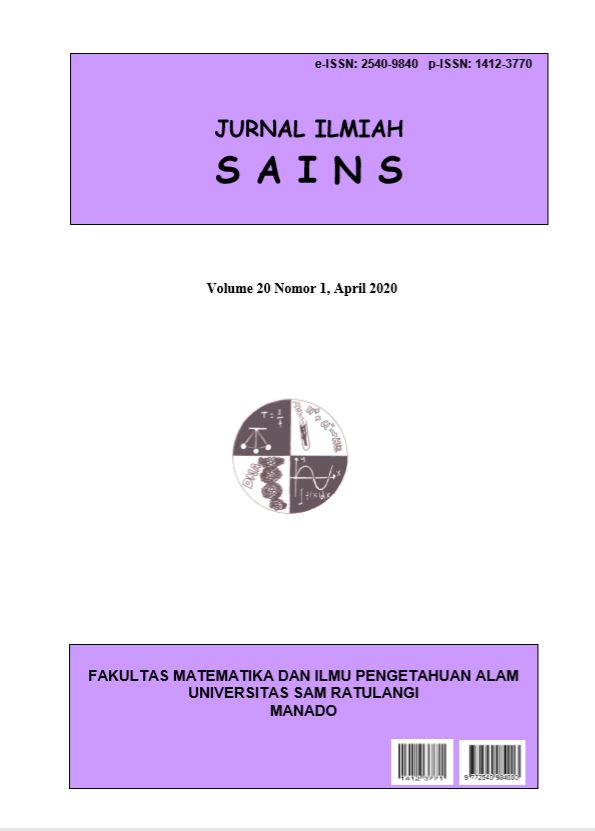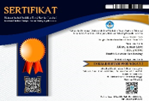Evaluasi Deteksi Berbasis PCR untuk Bakteri Bifidobacterium longum dalam Sampel Feses Bayi dari Kota Manado
DOI:
https://doi.org/10.35799/jis.20.1.2020.27702Abstract
Bifidobakteria merupakan mikroflora yang umum hidup dalam usus manusia sejak bayi. Peran Bifidobacterium longum yang positif sebagai salah satu bakteri yang menunjang kesehatan inangnya membuat bakteri ini menjadi objek studi yang menarik. Salah satu instrumen dalam penelitian adalah adalah metode deteksi bakteri B. longum yang berbasis PCR (Polymerase Chain Reaction) gen 16S rRNA. Dengan mempertimbangkan bahwa perancangan primer untuk deteksi ini sudah lebih dari 20 tahun, penelitian ini bertujuan mengevaluasi hasil deteksi melalui PCR terhadap B. longum dalam feses bayi. Akurasi hasil dilihat melalui sekuensing terhadap hasil PCR sampel yang terdeteksi positif. Dua sampel feses bayi di Manado yang diperiksa menunjukkan hasil positif dan produk PCR tersebut dilakukan sekuensing. Panjang DNA yang nyata dari hasil deteksi ini yaitu 829 bp dan bukan 831 bp. Sekuens DNA kedua sampel ini identik satu sama lain. Hasil BLAST (Basic Local Alignment Search Tool) mengonfirmasi kesamaan 100% (identik) dari kedua specimen dari Kota Manado dengan sekuens gen 16S rRNA specimen bakteri B. longum yang telah ada dalam GenBank.
Kata-kata kunci: Bifidobacterium longum, Polymerase Chain Reaction, deteksi, feses, bayi.
Â
Evaluation of PCR-Based Detection for Bifidobacterium longum in Infant Fecal Samples from Manado City
 ABSTRACT
Bifidobacteria are common members of the gut microflora of humans since infant. The Bifidobacterium longum has positive roles and one of supportive bacteria to the host, which made interesting as a study object. One instrument in studying this bacterial species is the detection method based on PCR of 16S rRNA gene. In consideration of the design of primers for this detection method is already more than 20 years, this research aimed to evaluate the PCR-based detection of B. longum in infant feces. The accuracy of the method was evaluated from sequencing of DNA fragment from positive results. Two fecal samples in Manado City shown positive result were sent for sequencing. The actual length of DNA amplified by PCR was 829 bp, not 831 bp. The DNA sequence of both samples were identical to each other. The BLAST (Basic Local Alignment Search Tool) result confirmed the similarity of both samples from Manado with 16S rRNA gene sequence of B. longum specimens in GenBank.
Keywords: Bifidobacterium longum, Polymerase Chain Reaction, detection, feces, infant.
References
Achi, S.C. & P.M. Halami. 2019. In Vitro Comparative Analysis of Probiotic and Functional Attributes of Indigenous Isolates of Bifidobacteria. Curr. Microbiol. 76: 304–311.
Altschul, S.F., W. Gish, W. Miller, E.W. Myers, & D.J. Lipman. 1990. Basic Local Alignment Search Tool. Journal of Molecular Biology 215(3): 403-410.
Drummond A.J., B. Ashton, S. Buxton, M. Cheung, A. Cooper A, C. Duran, M. Field, J. Heled, M. Kearse, S. Markowitz, R. Moir, S. Stones-Havas, S. Sturrock, T. Thierer & A. Wilson. 2012. Geneious v5.6. New Zealand.
Edgar, R.C. 2004. MUSCLE: Multiple Sequence Alignment with High Accuracy and High Throughput. Nucleic Acids Research 32(5): 1792–1797.
Fukuda, S., H. Toh, K. Hase, K. Oshima, Y. Nakanishi, K. Yoshimura, T. Tobe, J.M. Clarke, D.L. Topping, T. Suzuki, T.D. Taylor, K. Itoh, J. Kikuchi, H. Morita, M. Hattori & H. Ohno. 2011. Bifidobacteria can Protect from Enteropathogenic Infection through Production of Acetate. Nature 469: 543–547.
Gavini, F., C. Cayuela, J. Antoine, C. Lecoq, B. Lefebvre, J. Membré & C. Neut (2001) Differences in the Distribution of Bifidobacterial and Enterobacterial Species in Human Faecal Microflora of Three Different (Children, Adults, Elderly) Age Groups. Microbial Ecology in Health and Disease 13(1): 40-45.
Hernández-RodrÃguez, D., A.A. Vásquez-Aguilar, J.C. Serio-Silva, E. Rebollar, A. Azaola-Espinosa. 2018. Molecular Detection of Bifidobacterium spp. in Faeces of Black Howler Monkeys (Alouatta pigra). J. Med. Primatol. 48(2): 99-105.
Kolondam, B.J. 2015. Applying matK Gene for Identification of Liliopsida Plant Species from North Sulawesi through Bold Systems. International Journal of Applied Biology and Pharmaceutical Technology 6(2): 242-245.
Matsuki, T., K. Watanabe, R. Tanaka, M. Fukuda & H. Oyaizu. 1999. Distribution of Bifidobacterial Species in Human Intestinal Microflora Examined with 16S rRNA Gene-targeted Species-specific primers. Appl. Environ. Microbiol. 65: 4506–4512.
Messaoudi, M., R. Lalonde, N. Violle, H. Javelot, D. Desor, A. Nejdi, J.F. Bisson, C. Rougeot, M. Pichelin & J. Cazaubiel. 2011. Assessment of Psychotropic-like Properties of a Probiotic Formulation (Lactobacillus helveticus R0052 and Bifidobacterium longum R0175) in Rats and Human Subjects. British Journal of Nutrition 105(5): 755-764.
Moreno, C., J. Romero & R.T. Espejo. 2002. Polymorphism in Repeated 16S rRNA Genes is a Common Property of Type Strains and Environmental Isolates of the Genus Vibrio. Microbiology 148: 1233–1239.
Motherway, M.O.C. A. Zomer, S.C. Leahy, J. Reunanen, F. Bottacini, M. J. Claesson, F. O'Brien, K. Flynn, P. G. Casey, J.A.M. Munoz, B. Kearney, A.M. Houston, C. O'Mahony, D.G. Higgins, F. Shanahan, A. Palva, W.M. de Vos, G.F. Fitzgerald, M. Ventura, P.W. O'Toole & D. van Sinderen. 2011. Functional Genome Analysis of Bifidobacterium breve UCC2003 Reveals Type IVb Tight Adherence (Tad) Pili as an Essential and Conserved Host-colonization Factor. Proc. Natl. Acad. Sci. USA 108: 11217–11222.
Neefs, J.-M., Y.V. de Peer, P.D. Rijk, A. Goris & R.D. Wachter. 1991. Compilation of Small Ribosomal Subunit RNA Sequence. Nucleic Acids Res. 19: 1987–2015.
Oki, K., T. Akiyama, K. Matsuda, A. Gawad, H. Makino, E. Ishikawa, K. Oishi, A. Kushiro & Junji Fujimoto. 2018. Long-term Colonization Exceeding Six Years from early Infancy of Bifidobacterium longum subsp. longum in Human Gut. BMC Biology 18(1): 209.
Priha, O., M. Raulio, J. Maukonen, A. Vehviläinen & E. Storgårds. 2016. Bacterial Populations on Brewery Filling Hall Surfaces as Revealed by Next Generation Sequencing. Biofouling 32(5): 571-581.
Tojo, R., A. Suárez, M.G. Clemente, C.G. de los Reyes-Gavilán, A. Margolles, M. Gueimonde & P. Ruas-Madiedo. 2014. Intestinal Microbiota in Health and Disease: Role of Bifidobacteria in Gut Homeostasis. World J. Gastroenterol. 20: 15163–15176.
Turroni, F., E. Foroni, P. Pizzetti, V. Giubellini, A. Ribbera, P. Merusi, P. Cagnasso, B. Bizzarri, G. L. de'Angelis, F. Shanahan, D. van Sinderen, M. Ventura. 2009. Exploring the Diversity of the Bifidobacterial Population in the Human Intestinal Tract. Applied and Environmental Microbiology 75(6): 1534-1545.
Temmerman, R., G. Huys & J. Swings. 2004. Identification of Lactic Acid Bacteria: Culture-dependent and Culture-independent Methods. Trends in Food Science & Technology 15(7): 348–359.
Uraipan, S. & T. Hongpattarakere. 2015. Antagonistic Characteristics Against Food-borne Pathogenic Bacteria of Lactic Acid Bacteria and Bifidobacteria Isolated from Feces of Healthy Thai Infants. Jundishapur J. Microbiol. 8(6): e18264.
Ventura, M., F. Turroni, M.O.C. Motherway, J. MacSharry & D. van Sinderen. 2012. Host-microbe Interactions that Facilitate Gut Colonization by Commensal Bifidobacteria. Trends Microbiol. 20: 467–476.
Vlková, E., L. Kalous, V. BuneÅ¡ová, K. Rylková, R. SvÄ›tlÃková & V. Rada. 2012. Occurrence of Bifidobacteria and Lactobacilli in Digestive Tract of Some Freshwater Fishes. Biologia 67: 411-416.
Ward, D.M., M.J. Ferris, S.C. Nold & M.M. Bateson. 1998. A Natural View of Microbial Biodiversity within Hot Spring Cyanobacterial Mat Communities. Microbiology and Molecular Biology Reviews 62: 1353–1370.
Wei, L. 2019. Bifidobacterium longum strain ZJ1 16S ribosomal RNA gene, partial sequence. https://www.ncbi.nlm.nih.gov/nucleotide/MN372103.1 [diakses 21 Jan 2020].
Xiao, W., F. Lin, & Y. Hou. 2019. The Complete Genome Sequence of Bifidobacterium longum BAMA-B05. https://www.ncbi.nlm.nih.gov/nucleotide/CP043002.1 [diakses 21 Jan 2020].
Yatsunenko, T., F. Rey, M. Manary, I. Trehan, M.G. Dominguez-Bello, M. Contreras, M. Magris, G. Hidalgo, R.N. Baldassano, A.P. Anokhin, A.C. Heath, B. Warner, J. Reeder, J. Kuczynski, J.G. Caporaso, C.A. Lozupone, C. Lauber, J.C. Clemente, D. Knights, R. Knight & J.I. Gordon. 2012. Human Gut Microbiome Viewed Across Age and Geography. Nature 486: 222–227.







